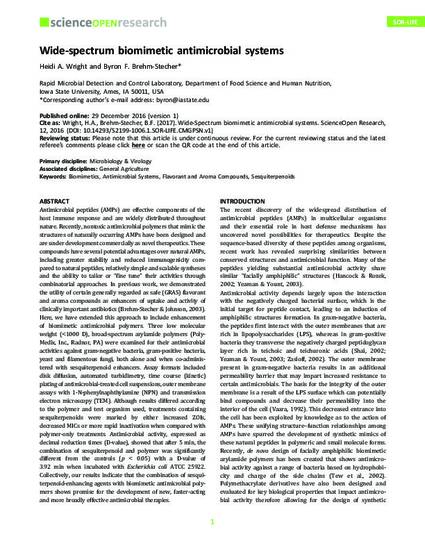
Antimicrobial peptides (AMPs) are effective components of the host immune response and are widely distributed throughout nature. Recently, nontoxic antimicrobial polymers that mimic the structures of naturally occurring AMPs have been designed and are under development commercially as novel therapeutics. These compounds have several potential advantages over natural AMPs, including greater stability and reduced immunogenicity compared to natural peptides, relatively simple and scalable syntheses and the ability to tailor or “fine tune” their activities through combinatorial approaches. In previous work, we demonstrated the utility of certain generally regarded as safe (GRAS) flavorant and aroma compounds as enhancers of uptake and activity of clinically important antibiotics (Brehm-Stecher & Johnson, 2003). Here, we have extended this approach to include enhancement of biomimetic antimicrobial polymers. Three low molecular weight (<1000 D), broad-spectrum arylamide polymers (PolyMedix, Inc., Radnor, PA) were examined for their antimicrobial activities against gram-negative bacteria, gram-positive bacteria, yeast and filamentous fungi, both alone and when co-administered with sesquiterpenoid enhancers. Assay formats included disk diffusion, automated turbidimetry, time course (kinetic) plating of antimicrobial-treated cell suspensions, outer membrane assays with 1-N-phenylnaphthylamine (NPN) and transmission electron microscopy (TEM). Although results differed according to the polymer and test organism used, treatments containing sesquiterpenoids were marked by either increased ZOIs, decreased MICs or more rapid inactivation when compared with polymer-only treatments. Antimicrobial activity, expressed as decimal reduction times (D-value), showed that after 5 min, the combination of sesquiterpenoid and polymer was significantly different from the controls (p < 0.05) with a D-value of 3.92 min when incubated with Escherichia coli ATCC 25922. Collectively, our results indicate that the combination of sesquiterpenoid-enhancing agents with biomimetic antimicrobial polymers shows promise for the development of new, faster-acting and more broadly effective antimicrobial therapies.
Available at: http://works.bepress.com/byron_brehmstecher/21/

This article is published as Wright, H.A. and Brehm-Stecher, B.F. Wide-spectrum biomimetic antimicrobial systems. ScienceOpen Research: doi: 10.14293/S2199-1006.1.SOR-LIFE.CMGPSN.v1 (2016).